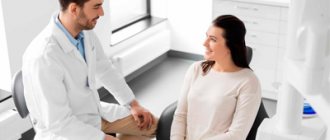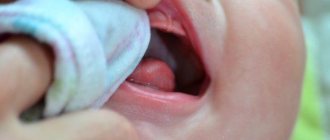Content:
- Possible reasons
- Dental causes of inflammation of the lymph nodes on the chin
- How to understand that the problem is in the lymph nodes
- Diagnostic measures
- How are lymph nodes treated?
- Preventive measures
If the lymph nodes are inflamed, it is important to undergo a comprehensive medical examination.
This condition can be accompanied by many diseases, both related to the field of dentistry and not related to it. Lymph nodes are peripheral organs of the lymphatic system. They perform the functions of a biological filter. Passing through their tissues, lymph enters different parts of the body and internal organs.
If the lymphoid structure has increased, it means there is an inflammatory process. It is necessary to find out as soon as possible what functional disorders it is associated with. This will allow you to create an effective treatment plan and prevent the development of severe complications.
Diagnosis of the disease
Diagnostic procedures involve identifying the primary source of the disease. The first instance that a person with inflamed nodes in the parotid area needs to visit is a family doctor or therapist; for children, a pediatrician.
The doctor conducts a preliminary examination of the patient with palpation of the inflamed area. Based on the examination and complaints of the patient, a preliminary diagnosis of “parotid lymphadenitis” can be made. Next, the patient will have to undergo a series of specialists to determine the source of infection, as well as undergo standard laboratory tests. Additionally, the patient may be prescribed an ultrasound examination of the inflamed segment.
Further diagnostic procedures depend on individual indicators specific to the patient. If the source of lymphatic inflammation is “on the surface,” then steps are taken to treat it. Otherwise, the search involves additional tests and a comprehensive examination of the body.
The international classification of diseases ICD-10 classifies lymphadenitis in the section “Infections of the skin and subcutaneous tissue.” Inflammation of the parotid lymph nodes in medical documentation is identified by code L 04.0, indicating the localization of infected lymph nodes on the neck, face or head.
Possible reasons
The lymphatic system is the basis of immunity . It prevents the spread of pathological microorganisms and blocks the occurrence of many disease processes. In various diseases, lymphocytes begin to actively multiply to slow down inflammation. Then the lymph nodes enlarge.
If structures localized under the jaw and in the neck area “grow,” it is most likely an infection, that is, the disorder is caused by bacteria. But sometimes the condition occurs in the absence of infection.
Among the most common infectious causes:
- Colds, viruses. Their pathogens affect the ENT organs, and general intoxication is observed. In this scenario, sore throats, pharyngitis, tonsillitis, acute respiratory viral infections, acute respiratory infections, sinusitis, otitis media, etc. occur.
- Tuberculosis. With lymphadenitis, the entire neck swells. In advanced cases, lymphoid tissues located in the abdominal cavity and chest increase. The pathology is treated conservatively and surgically.
- Dental problems. Pulpitis, caries, periodontitis - all these are provoking diseases.
- Toxoplasmosis. People become infected with it from domestic animals (most often from cats). In addition to the growth of nodes, with this diagnosis the following are observed: high body temperature, headaches, an increase in the size of the spleen and liver. But very often the disease is asymptomatic.
- Venereal pathologies. Transmitted sexually. The body reacts very sharply to most of them, so already in the first days the patient notices that the lymph nodes have become enlarged and began to hurt, and severe weakness has appeared.
- Herpes. It manifests itself as an increase in the volume of lymphoid tissue in the neck, under the jaw and in the groin. Requires competent antiviral therapy.
Among the factors of a non-infectious nature that lead to the appearance of an unfavorable symptom:
- Oncology. It does not matter whether cancer of the lymphatic system or any internal organ is diagnosed. But in the first case, cancer cells quickly spread with the lymph flow, which contributes to the formation of metastases.
- Autoimmune pathologies. These are conditions in which the immune system begins to malfunction, causing serious damage to the body. This group includes systemic lupus, rheumatoid arthritis, type 1 diabetes, etc.
- Allergy. It manifests itself differently in all people. The most common symptoms are skin rashes and itching. But lymph can also be involved in the allergic process.
- Traumatic injuries to the head and face. If a strong pathological process occurs, lymphocytes begin to be actively produced.
Factors in the development of inflammatory processes in the parotid lymph nodes
Lymph nodes are a kind of security points through which lymph passes, clearing itself of agents of infectious and viral origin, preventing their further spread throughout the body. With normal functioning and the absence of infections in the body, the nodes operate normally, however, if the coefficient of negative components goes off scale, the lymphatic modules let the person know about this with a corresponding signal from a certain system of nodal formations.
Medicine divides the root causes of parotid lymphadenitis into two large categories: specific and nonspecific provocateurs. The first group of pathology initiators includes:
- the presence of problems of autoimmune origin in the body - HIV or AIDS;
- tuberculosis and cancer;
- complex disturbances in the functioning of endocrine and lymphatic complexes, serious disruptions in hematopoietic processes;
- measles, rubella and other viral diseases of complex etiology.
Postauricular lymphadenitis of a nonspecific type develops mainly against the background of infection of the body with staphylococcal or streptococcal bacilli, as well as other viral pathogens:
- problems that can be caused by ineffective sanitation of the oral cavity (these include extensive caries, periodontal disease);
- inflammation of the ear of a complex category;
- viral respiratory diseases;
- allergic reactions caused by eczema or psoriasis;
- boils or untreated wounds and abrasions as sources of infection.
In the adult population, the source of pathology can be harmful habits, such as alcohol abuse and smoking, however, a 100% cause-and-effect relationship between these habits and pathology has not been proven by science.
Dental causes of inflammation of the lymph nodes on the chin
Since very often in their work dentists are faced with huge lymph nodes in patients, let us dwell in more detail on the diseases that cause this symptom:
- Periodontitis. It can occur in acute or chronic form. Leads to tooth loosening and severe pain. If you do not receive qualified dental care in time, there will be a need to remove the affected unit.
- Stomatitis. Causes painful ulcers to appear on the mucous membranes of the mouth. It is the result of injuries, low immunity, vitamin deficiency. In advanced cases, the entire oral cavity becomes covered with wounds. Then active production of lymphocytes is observed.
- Pulpitis. Inflammatory lesion of pulp tissues. A very insidious disease. Through the pulp, pathogenic microorganisms penetrate into the lymph nodes and other tissues. It is important to clean the canals and seal them as soon as possible.
- Advanced caries. Despite the fact that many people do not take caries seriously, it is a rather insidious infectious process. If the deep tissues of the tooth are damaged, the lymph nodes come to the aid of the body - they try to neutralize pathological agents by producing lymphocytes. This can be understood by their increased size.
- Periodontal disease. Causes hypertrophy of periodontal tissues, leading to local hypoxia. Periodontal disease does not cause pain, so most often the patient learns about it by chance during a medical examination for some other condition. With periodontal disease, the gums become lighter, the interdental papillae atrophy, and the dental necks become exposed. If treatment is not started in time, the teeth will begin to loosen and fall out.
- Periodontitis. A disease that develops due to metabolic disorders, neurosomatic abnormalities, poor oral hygiene, and deficiency of vitamins and minerals. It manifests itself as bleeding gums, bad breath, and loose teeth.
- Gingivitis. Inflammatory reaction in the gums. Appears against the background of gastrointestinal pathologies, allergies, infections. The patient experiences bleeding gums even with minor mechanical stress. A burning sensation in the mouth bothers me. Ulcerative-necrotic areas may form.
These are not all dental conditions in which the lymph nodes under the chin become inflamed. In medical practice there are many more such diagnoses. This once again proves that the patient himself will not be able to understand why his submandibular area is swollen.
Oncology and enlarged cervical lymph nodes
Some cancers (lymphomas) arise and develop in the lymph nodes. They are classified as:
- Hodgkin's lymphoma;
- Non-Hodgkin's lymphomas.
But more often metastases penetrate the lymph nodes.
This occurs due to the ability of cancerous tumors to metastasize. Benign tumors do not have this ability.
Breaking away from the lesion, the mutated cells migrate, enter the blood and lymphatic vessels and create secondary lesions. The lymph nodes adjacent to the primary lesion become the most vulnerable.
How to understand that the problem is in the lymph nodes
Among the symptoms indicating damage to the lymph nodes:
- pain in the area where they are located;
- migraine;
- weakness;
- increased body temperature;
- discomfort under the chin;
- unpleasant pulsation in the lower jaw;
- difficulty chewing food;
- swelling noticeable to the naked eye.
If a purulent process develops, the skin in the area of inflammation becomes red and becomes very hot to the touch. Additionally, symptoms characteristic of the disease that provoked the disorder may appear.
Methodology for the treatment of lymphadenitis of the parotid lymph nodes
The methodology for treating lymphadenitis of the parotid region varies depending on the form of the progressive disease and its stage. In the situation with parotid lymphadenitis, medicine provides an integrated approach to therapy, aimed at parallel elimination of negative symptoms, using local treatment of the lesion, taking antibacterial drugs, and targeted treatment of the original source of the pathology. If the disease is purulent, surgical intervention may be required.
Let us consider in more detail each of the areas of treatment of the disease, the rationality of its use in each specific case.
Antibacterial therapy vector
Antibiotics for lymphadenitis behind the ear are one of the central vectors for treating the disease, used for any form of pathology. In each specific case, the specialist selects the most effective antibacterial medication that will affect the source of the disease.
If the disease is provoked by infectious diseases of the standard category, the patient is predominantly prescribed antibiotics with extensive effects on the body. In mild forms of the disease, preference is given to tablet drugs, such as Amoxiclav, Ciprofloxacin, Biseptol and others. In difficult cases, inpatient treatment of the disease may be prescribed with the administration of antibiotics by injection. At the same time, the doctor controls the situation, regularly examining the patient and determining the effectiveness of therapy; if necessary, the antibacterial agent can be replaced.
Amoxiclav
If the patient has a specific type of pathology, then he is prescribed antibiotics of the appropriate category. In this case, it is important that antibiotic therapy does not cause more significant harm to the body and is in harmony with the treatment carried out for the underlying disease.
Painkillers
An equally important task for the doctor in the treatment of parotid lymphadenitis is to relieve intense pain that bothers the patient. During the period of exacerbation, pain symptoms are piercing in nature, which aggravates the general health of the patient and affects the effectiveness of the main therapy.
To eliminate pain, medications such as Ibuprofen or Paracetamol can be used, which, in addition to the analgesic effect, help stabilize body temperature and are characterized by a slight anti-inflammatory effect.
If the pain syndrome is not severe, the use of drugs in this category is contraindicated. In addition, the uncontrolled use of painkillers is strictly prohibited; they can only be used as prescribed by a doctor and in appropriate dosages, so as not to disrupt the dynamics of the effectiveness of therapy.
Antiallergic drugs
The antiallergic direction of treatment in the complex therapy of the disease is used in situations where the primary source of the pathology is allergen-type provocateurs. It is also permissible to prescribe drugs of the antiallergic class when a patient is taking antibiotics, which have allergic reactions as contraindications.
The appropriateness of using antiallergic therapy is assessed by the attending physician, with preference given to third-generation medications, which are characterized by a minimal number of adverse reactions and the absence of a hypnotic effect on the body.
Local therapy
Local treatment of the inflamed segment is an effective method of influencing the symptoms of the disease. Special medical products for external use, such as Sinalar or Dimexide, help reduce swelling and tissue regeneration inside the lesion.
Dimexide
If there are purulent formations in the area of the hearing aid, compresses with Ichthyol ointment or Vishnevsky ointment can be prescribed, which contribute to the effective release of purulent accumulations to the outside. It is rational to use these drugs only in cases where the inflammation is extensive.
Ear lymphadenitis is strictly forbidden to be treated with hot compresses or heating - this can contribute to the appearance of suppuration in the node with all the ensuing consequences. Applying cold compresses to “reduce swelling” is also strictly contraindicated, as it can cause even greater inflammation of already problematic lymph nodes.
Surgery
The radical, last resort treatment for lymphadenopathy is surgery. Doctors resort to such an extreme method of treatment only in cases where other methods of treating postauricular lymphadenitis are not effective, or the cause of inflammation is oncological in nature.
Diagnostic measures
Detecting the problem is very simple - the doctor just needs to feel the area under the chin and carefully examine it. To establish the exact cause of the disease, you need:
- Take blood and urine tests. From them you can understand the nature of the “provocateur” (viral or bacterial).
- Donate blood biochemistry.
- Get an ultrasound of the lymph nodes.
If the doctor suspects oncology, the patient is referred for a computed tomography or magnetic resonance imaging scan or a puncture biopsy. These diagnostic measures allow you to make a correct diagnosis and select adequate treatment.
How are lymph nodes treated?
The treatment tactics chosen by the doctor directly depend on the characteristics of the clinical symptoms and the diagnosis. If it's all about a bacterial infection, you can't do without antibiotics. For viruses, antiviral drugs and immunostimulants are indicated. In the case of an autoimmune disorder, the focus is on reducing the activity of specific culprit markers. If cancer is confirmed, chemotherapy, surgery, and immunomodulators are necessary.
If the lymph nodes are enlarged due to a certain dental disease, its step-by-step treatment is carried out. Almost immediately after this, the problem of increased lymphocyte production disappears by itself.
It is extremely important that the patient does not warm the lymph node or apply any compresses unless the doctor has prescribed it. Such actions can aggravate the situation and lead to the development of health-threatening complications.
Indications
There are many indications for the procedure:
- Node over 1 cm;
- Soreness;
- Inflammatory process for no apparent reason;
- Suspicion of a malignant tumor;
- The lymph node does not change, although treatment has been carried out for a long time;
- Sarcoidosis or lymphogranulomatosis, etc.
This procedure provides an understanding of:
- What is the specificity of the course of the disease;
- What is the level of infection;
- If a patient with cancer has metastases.
Preventive measures
No one is immune from the problem described. But there are ways to minimize the risk of its occurrence. Among them:
- receiving qualified medical care for any ailments;
- annual laboratory tests;
- timely treatment of emerging dental diseases;
- sanitation of the oral cavity every six months;
- following medical prescriptions.
Take care of your health, and the risk of enlarged lymph nodes will be minimized.
Metastasis to cervical lymph nodes
Cervical lymph nodes are at greater risk of metastasis. It is there that metastases of squamous cell carcinoma of the upper respiratory tract, cancer of the thyroid gland, skin and salivary glands penetrate.
Sometimes the primary lesion is localized in another part of the body:
- Breast cancer – up to 4.5% of cases;
- Lung cancer – up to 32% of cases;
- Oncology of the esophagus – up to 30% of cases;
- Kidney cancer – up to 8% of cases;
- Testicular cancer – up to 4.5%.
Minor rates of metastasis were diagnosed in oncology of the cervix, uterine body, prostate, central nervous system, liver, bladder, and ovaries.









